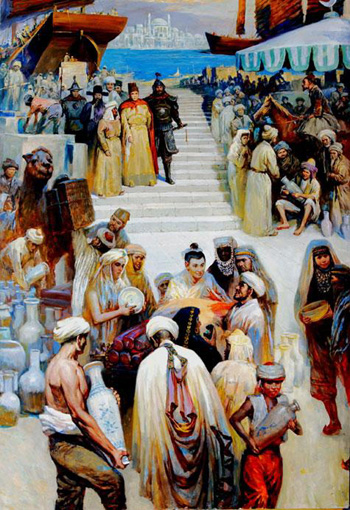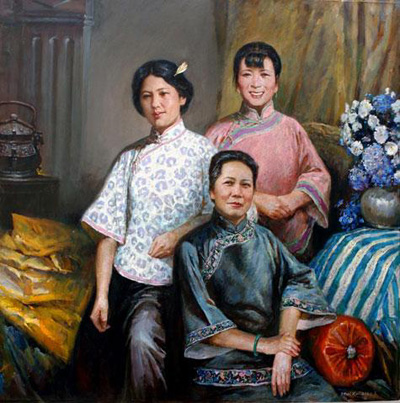While many young contemporary Chinese artists are eager to display their individualistic styles, veteran Xu Chunzhong has a very different view. He is painting the nation's history.
Xu Chunzhong
At a first glance, veteran artist Xu Chunzhong's series of oil paintings depicting major moments in Chinese history seems out of place. The current trend in the contemporary art market favors ideological works representing artists' individualistic ideas.
But the works of 60-year-old Xu, who has studied painting since the age of five under many masters, are highly structured with disciplined use of color.
They are also huge in size ranging from 180cm by 250cm to 400cm by 180cm. And most significantly his depiction of epic events is nothing short of startling and confronting for viewers.
Xu, an art professor at University of California, Los Angeles (UCLA), for the past 13 years, knows his work bucks the current trend but that has not stopped him devoting the past eight years to his ongoing project.
And instead of selling his paintings, he has donated many to museums in both China and United States.
"I have a stable income from teaching and don't have to strive for high prices for my works," he says. "I want to preserve and promote Chinese history through art.
"Nobody is doing this, most people are just rushing their works to make quick money. But I don't care about how unfashionable it seems."
Xu, who was among China's most famous propaganda painters during the "cultural revolution" (1966-76), has been on an extended visit to Shanghai since late last year after exhibiting some of his work at the Shanghai International Arts Festival.
Oil painter Xu Chunzhong has created an outstanding body of work, including these depicting major moments and events in Chinese history.
He has continued to work here and also fulfill his role as president of the Yan Huang Art Institute but will return to the US at the end of the month.
Xu recalls that when he first arrived in America in 1995, he attended many gatherings of Chinese Americans.
"They are always concerned about their political role in American society," he says. "Chinese Americans were involved in many historical moments in US history, but so many people just don't know about it."
The gatherings prompted him to produce an extremely popular series of 12 oil paintings highlighting the role of Chinese Americans in American history, including the Civil War, the building of railways and more recently Chinese American involvement in the war in Iraq.
Encouraged by the success of that series, eight years ago Xu decided to tackle a project depicting glorious moments in Chinese history.
He plans to draw around 70 oil paintings and has so far completed 56.
"It is extremely difficult to pick 70 moments from the country's 5,000-year history," says Xu, who decided to break the work into four categories.
Stories about Chinese heroes, especially those fighting invaders, are always Xu's favorites. The series includes many traditional tragic heroes like Yue Fei, a brave general in the Song Dynasty (960-1279) killed by his own emperor.
Xu also devoted one painting to Mei Lanfang, a Peking Opera master who refused the invitation to perform for Japanese invader during the war.
The second category includes Chinese inventors like Cai Lun who invented paper production, while the third category encompasses dramatic and exciting moments in history. The final category coveres China's communication and opening to the outside world.
As he did for the series on Chinese Americans, Xu conducted detailed historical research. "Of course, these are just basic categories and they could overlap at times," explains Xu.
For example "Xuan Zang in Fire Mountain" depicts the inspiration for the classic Chinese novel "Journey to the West" where the legendary monk walked for thousands of miles to get Buddhist volumes from India. He was accompanied by a foreign servant who later was transformed into the Monkey King in the novel.
Carefully studying the background of the era, Xu gave the monk some impressive equipment such as a monk's stick featuring a triangular head which was typical for Indian monks at the time. Xu admits it is virtually impossible to turn so much Chinese history into one series of oil paintings, so he is working on another series of 100 traditional Chinese paintings.
Having taught at UCLA since 1995, Xu also became the first person of Chinese heritage to be awarded the American Red Cross Hero certificate by US Congress for his series of paintings covering the September 11 terrorist attacks in New York.
On September 11, 2001, Xu's sister telephoned him soon after the World Trade Center was attacked. She was trapped on the 66th floor but managed to escape due to the courage of firefighters and police officers.
Touched by the rescue, Xu spent 10 days on three oil paintings depicting the heroic firefighters and policemen. Signed over to the US government by Xu, the paintings were made into posters and postcards and sold all around the nation.
"Many contemporary Chinese artists, especially young ones, are distanced from the society. They criticize it but they don't really care about it. They want to show their own individualistic styles," says Xu. "But I want to serve the society with art."
(Shanghai Daily January 18, 2008)




